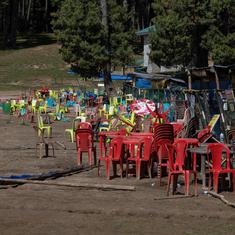The biggest losers in any conflict are women and children; the Spanish Civil War of the 1930s was no exception. The Civil War has been a favourite subject among artists, poets, authors and essayists on both sides of the political divide. Pablo Picasso’s Guernica is one such cultural symbol depicting the horror unleashed by the fascists led by General Francisco Franco that by one estimate left 2,00,000 people dead.
Though not very famous in the English-speaking world before its translation, Paracuellos: Children of the Defeated in Franco’s Fascist Spain by Carlos Giménez is the one that comes close to Guernica from the world of comics. Four decades after the publication of the Paracuellos I in Spain, the short stories about children continue to be an important document of the Franco era and an example of brilliant autobiographical graphic narrative.
Published as a strip in 1976, Paracuellos is a series of stories about children of the defeated who were cooped up in orphan homes – Hogares de Auxillo Social – after the Civil War. While the propaganda machine worked overtime to establish these orphan homes as Franco’s monuments of benevolence, what happened inside them largely remained unsaid. After the death of the Spanish dictator in 1975, Giménez, one of the orphan home boys, started publishing his strips.
The Franco boys
During the long period of silence, sustained efforts to airbrush history of the conflict resulted in generations that grew up unaware of atrocities of the Franco regime. Paracuellos holds a mirror to the period that many in Spain thought as a better-not-discussed chapter of the nation’s history. The graphic novel showcases Giménez’s artistic as well documentary abilities in capturing the life of children who were being brought up to become Franco boys.
Giménez’s strident denunciation of the very regime that created the homes to groom obedient boys throughout the body of the comic acts as a common thread that holds the narrative together. His masterful transition from one story to the other creates a seamless reading experience and the reader often forgets that they are stitched together newspaper comic strips of memory bits.
How a state deals with the other is portrayed in the most intimate way by the Spanish cartoonist. The stories in Paracuellos depict how, often in most ridiculous ways, the Franco acolytes used all the tools for subjugation – discipline, time regulations, body classification and forced segregation – to re-educate young minds. In one story, the boys were forced to take afternoon naps under the sun and soon the entire group was made to do pushups for reasons as ludicrous as swatting a fly sitting on one’s nose, the sound made by passing wind, and smiling on hearing that sound.

Surviving on humour
Humour does a play a big role in Paracuellos, it helps create a living bond between the characters of the stories and the readers. Though Giménez used humour to create empathy, he seemed to be aware of fact that the stories could be categorised as funny cartoons. In fact, in his dedication piece, published along with the Paracuellos II collection of stories, the cartoonist wrote: ‘To [Marcel] Gotlib and Diament, who dared to publish Paracuellos in Fluide Glacial, a Belgian-French magazine designed to produce laughter, even though Paracuellos is meant to cause tears, an act that could have sunk their magazine.”
The helplessness of the children in Paracuellos against remorseless violence is brought to focus by the tenderness of Giménez’s drawing strokes. Along with the depiction of the suffering of their family members who are forced to leave their children in the Hogares de Auxilio Social, it all forms a kind invisible alter for readers to shed their silent tears.
The farce inside the social homes, coupled with an eerie silence as far as news was concerned of the outside world – every letter was vetted and hardly any news was passed on to them – depicted in the comic evokes a sense of chill in the reader. Giménez successfully shares the pain of being a guinea pig of a social experiment to erase memories and after a few stories, the readers start to feel Modesto, Dead Tuna, Rudy, Adolfo and the rest of the children.

Breaking the silence
Paracuellos rejects the mystification that is associated with the “Pact of Silence” about the Civil War and the Franco repression perpetuated during the so-called “democratic period” in Spain. It serves as a manifesto for the victims of the war and the dictatorship. With its no frills, black-and-white, almost gutter-free narration, the stories in the graphic novel serve as a living guide to a past that some in Spain wanted to forget.
The power of Giménez’s work can be appreciated from the influence it has on readers even today. As dictatorship, both democratic and barbaric forms, repression and memory projects continue to invade the daily lives of people across the world, Paracuellos with its clear political agenda and no-nonsense storytelling will continue to relevant.

Paracuellos: Children of the Defeated in Franco’s Fascist Spain, Carlos Giménez, translated by Sonya Jones, IDW Publishing










